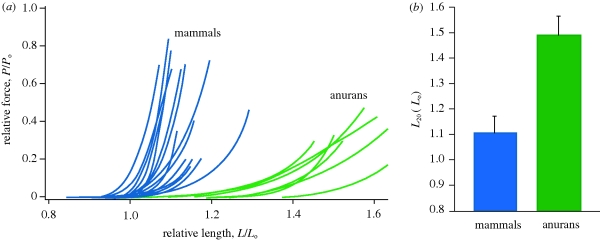Figure 5.
Meta-analysis of passive muscle properties. (a) Passive force–length curves are shown for 15 mammalian and 7 anuran hindlimb muscles. The data show that frog muscles can be stretched to longer muscle lengths relative to their optimal length (Lo) for a given force. (b) A comparison of the length (L20) at which muscles reach passive forces that correspond to 20 per cent of maximum active isometric force. Anuran muscles can be stretched to significantly (p < 0.0001) longer lengths for the same level of force. Data included in this analysis were limited to published studies of hindlimb muscles that measured both active and passive force–length properties and could therefore be normalized to Lo. Mammalian data are from: Gareis et al. (1992), Woittiez et al. (1983), Hawkins & Bey (1997), Davis et al. (2003), Witzmann et al. (1982), Rack & Westbury (1969) and Askew & Marsh (1998). Anuran data are from: Bagni et al. (1988), Julian & Moss (1980), this study, Talbot & Morgan (1998), Edman (1979), Altringham & Bottinelli (1985) and Ter Keurs et al. (1978). See electronic supplementary material, figure for more detail.

